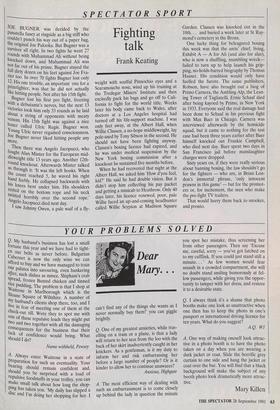SPECTATOR SPORT
Fighting talk
Frank Keating
JOE BUGNER was derided by the panatella fancy at ringside as a big stiff who couldn't punch his way out of a paper bag, the original Joe Palooka. But Bugner was a survivor all right. In two fights he went 27 rounds with Muhammad Ali without being knocked down, and Muhammad Ali was not far out of his prime. Bugner stayed the full dirty dozen on his feet against Joe Fra- zier too. In over 70 fights Bugner lost only 12. His one trouble, an important one for a prizefighter, was that he did not actually like hitting people. Not after his 15th fight. Bugner lost his first pro fight, freezing with a debutante's nerves, but the next 13 victories took him only 33 rounds as he laid about a string of opponents with meaty venom. His 15th fight was against a nice boxer called Ulric Regis. Bugner won. Young Ulric never regained consciousness. Joe Bugner never liked hitting people any more.
Then there was Angelo Jacopucci, who fought Alan Minter for the European mid- dleweight title 13 years ago. Another 12th- round knockout. Afterwards Minter talked us through it: 'It was the left hooks. When the count reached 5, he waved his right hand feebly. He collapsed backwards with his knees bent under him. His shoulders rested on the bottom rope and his neck twisted horribly over the second rope.' Angelo Jacopucci died next day. I saw Johnny Owen, a pale waif of a fly- weight with soulful Pinnochio eyes and a Scaramouche nose, wind up his training at the Tredegar Miners' Institute and then excitedly pack his bags and go off to Cali- fornia to fight for the world title. Weeks later his body came back to Wales, after doctors at a Los Angeles hospital had turned off his life-support machine. I was only feet away, at the Albert Hall, when Willie Classen, a no-hope middleweight, lay pole-axed by Tony Sibson in the second. He should not have been fighting anyway. Classen's boxing licence had expired, and he was under medical suspension by the New York boxing commission after a knockout he sustained five months before. When he had recovered that night at the Albert Hall, we asked him 'How d'you feel, kid?' He said he had double vision. But it didn't stop him collecting his pay packet and getting a minicab to Heathrow. Only 40 days later, his licence renewed, poor, pale Willie faced an up-and-coming headhunter called Willie Scypion at Madison Square Garden. Classen was knocked out in the 10th. . . and buried a week later at St Ray- mond's cemetery in the Bronx.
One lucky thing for beleagured boxing this week was that the antis' chief, living, Exhibit A — A for Ali (and also for alas), who is now a shuffling, mumbling wreck— failed to turn up to help launch his grip- ping, no-holds-barred biography by Thomas Hauser. His condition would only have fuelled the furore. The same publishers, Robson, have also brought out a biog of Primo Camera, the Ambling Alp, the Lean- ing Tower of Tagliatelli. Ernie Schaaf died after being kayoed by Primo, in New York in 1933. Everyone said the real damage had been done to Schaaf in his previous fight with Max Baer in Chicago. Camera was interviewed afterwards by the homicide squad, but it came to nothing for the test case had been three years earlier after Baer himself knocked out Frankie Campbell, who died next day. Baer spent two days in San Francisco jail before manslaughter charges were dropped.
Sixty years on, if they were really serious about banning boxing, the law shouldn't go for the fighters — who are, in Brian Lon- don's immortal phrase, 'only innocent prawns in this game' — but for the promot- ers or, for incitement, the men who make the pre-fight TV trailers.
That would hurry them back to snooker, and pronto.


































































 Previous page
Previous page